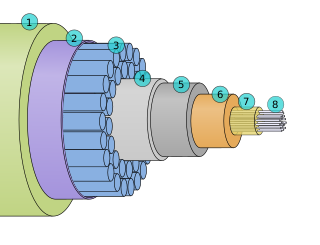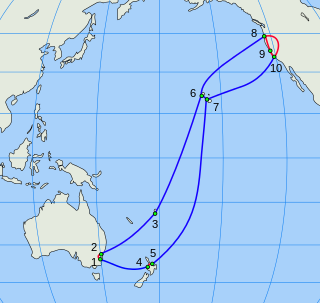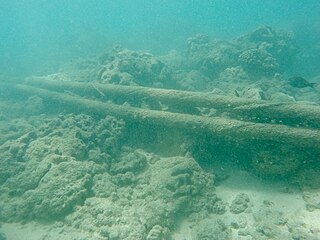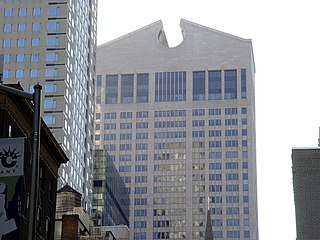Related Research Articles
Though Guam is a United States territory, some U.S. long-distance plans and courier services list Guam as an international location. As a result of Guam's being added to the North American Numbering Plan (NANP) in 1997, calls made to the U.S., Canada, or other participating countries from Guam only require the caller to dial a 1 followed by the area code.
A transatlantic telecommunications cable is a submarine communications cable connecting one side of the Atlantic Ocean to the other. In the 19th and early 20th centuries, each cable was a single wire. After mid-century, coaxial cable came into use, with amplifiers. Late in the 20th century, all cables installed used optical fiber as well as optical amplifiers, because distances range thousands of kilometers.

A submarine communications cable is a cable laid on the seabed between land-based stations to carry telecommunication signals across stretches of ocean and sea. The first submarine communications cables were laid beginning in the 1850s and carried telegraphy traffic, establishing the first instant telecommunications links between continents, such as the first transatlantic telegraph cable which became operational on 16 August 1858.

Commercial Pacific Cable Company was founded in 1901, and ceased operations in October 1951. It provided the first direct telegraph route from America to the Philippines, China, and Japan.

The Southern Cross Cable is a trans-Pacific network of telecommunications cables commissioned in 2000. The network is operated by the Bermuda-registered company Southern Cross Cables Limited. The network has 28,900 km (18,000 mi) of submarine and 1,600 km (990 mi) of terrestrial fiber optic cables, all which operate in a triple-ring configuration. Initially, each cable had a bandwidth capacity of 120 gigabit/s. Southern Cross offers capacity services from 100M/STM-1 to 100 Gbit/s OTU-4, including 1G, 10G and 40G Ethernet Private Line services.

A cable layer or cable ship is a deep-sea vessel designed and used to lay underwater cables for telecommunications, for electric power transmission, military, or other purposes. Cable ships are distinguished by large cable sheaves for guiding cable over bow or stern or both. Bow sheaves, some very large, were characteristic of all cable ships in the past, but newer ships are tending toward having stern sheaves only, as seen in the photo of CS Cable Innovator at the Port of Astoria on this page. The names of cable ships are often preceded by "C.S." as in CS Long Lines.
TPC-5CN or Trans-Pacific Cable 5 Cable Network is a submarine telecommunications cable system linking Japan, Guam, Hawaii and mainland United States.

Alcatel–Lucent S.A. was a multinational telecommunications equipment company, headquartered in Boulogne-Billancourt, France. It was formed in 2006 by the merger of France-based Alcatel and U.S.-based Lucent, the latter being a successor of AT&T's Western Electric and a holding company of Bell Labs.
PacRimWest was a twin-pair 560 Mbit/s optical submarine telecommunications cable which served as Australia's main link to the world along with its partner cables Tasman2 and PacRimEast.
Unity is a Trans-Pacific submarine communications cable between Japan and the United States that was completed in April 2010.
PIPE Pacific Cable (PPC-1) is a 6,900 km submarine cable laid by PIPE Networks. It runs from Cromer, New South Wales, in Australia, to Piti, Guam.
Communication services in American Samoa are diversified among telephony, radio broadcasting, television, and Internet services.

HAW-1 was the first submarine telephone cable laid between Hawaii and the mainland United States. HAW-1 was laid in 1957, and consisted of two cables, each transmitting in one direction over 36 channels, with an individual length of 2,625 Nmi (4,862 km). The cable spans between Hanauma Bay, Oahu, Hawaii and Point Arena, California.

AT&T Corporation, commonly referred to as AT&T, an abbreviation for its former name, the American Telephone and Telegraph Company, was an American telecommunications company that provided voice, video, data, and Internet telecommunications and professional services to businesses, consumers, and government agencies.

C.S. Sovereign is a class DP2 type cable ship used for subsea cable installation and repair works. The ship was designed by BT Marine with Hart Fenton & Company as Naval Architects and built by Van der Giessen de Noord in 1991.

The Mafuta is a diamond-mining ship owned and operated by De Beers in the western coast of South Africa. Built in 1983 as Dock Express 20 for Dock Express Shipping, the semisubmersible, multirole, heavy-lift vessel was converted to the world's largest cable layer in 1993. In 2005, she was purchased by De Beers, and converted to a subsea diamond-mining ship by A&P Tyne over the course of 11 months. The ship's new name, Peace in Africa, may have implied that it was providing an alternative to blood diamonds. In 2013, still under ownership of De Beers Marine Namibia, the vessel was renamed to MV Mafuta.
The Eastern Mediterranean Optical System (EMOS-1) is a fiber optic cable linking Palermo, Italy with Lechaina, Greece; Marmaris, Turkey and Tel Aviv, Israel, which was created in Turkey in 1991. Consisting of three pairs which are split en route through branching units. The ship CS Vercors laid the cable. Each pair of fibres are capable of transmitting 1920 telephone calls in each direction.
The CS Chamarel, originally CS Vercors was a cable layer owned by France Telecom Marine, laying submarine communications cables around the world. It was built in 1974 and destroyed by a fire in August 2012. As the Vercors, the ship laid cables on and between all continents except Antarctica, including numerous trans-Atlantic cables and the first ever Israeli-made cable, and set the record for the deepest submarine buried cable lay in 2000. The ship was badly damaged by a fire and driven aground on 8 August 2012.

MAREA is a 6,605 km long transatlantic communications cable connecting the United States with Spain. Owned and funded by Microsoft and Meta Platforms, but constructed and operated by Telxius, a subsidiary of the Spanish telecom company Telefónica, it is the "highest-capacity submarine cable in the world" with a system design capacity of 200 terabits per second as of 2019.
References
- ↑ "AT&T Tech Channel Archives: C.S. Long Lines". att.com. March 21, 2011. Retrieved November 19, 2021.
- ↑ "Submarine Cable Networks". submarinenetworks.com. Retrieved September 24, 2016.
- ↑ "Milestones:TPC-1 Transpacific Cable System, 1964". ethw.org. Engineering and Technology History WIKI. Retrieved September 24, 2016.
- ↑ Mike Dinn. "The Manned Spaceflight Network" . Retrieved September 24, 2016.
- 1 2 Calvin Sims (April 18, 1989). "Fiber-Optic Calling to Japan Starts Today". New York Times.
- ↑ Huurdeman, Anton A. (2003). The Worldwide History of Telecommunications. Wiley-IEEE. p. 405. ISBN 0-471-20505-2.
- ↑ "Congressional Affairs". Los Angeles Daily Herald. Los Angeles, CA. May 19, 1874. p. Image 3. Retrieved July 1, 2017– via Chronicling America: Historic American Newspapers. Lib. of Congress.
- ↑ "The Trans-Pacific Telegraph". Pacific Commercial Advertiser . September 23, 1876. p. Image 3. Retrieved July 1, 2017.
- ↑ "This Means a Cable". The Morning Call. San Francisco, CA. February 10, 1895. p. 4. Retrieved July 1, 2017– via Chronicling America: Historic American Newspapers. Lib. of Congress.
- ↑ "Corporate History". Kokusai Cable Ship.